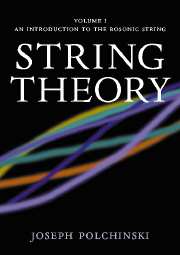Book contents
- Frontmatter
- Contents
- Foreword
- Preface
- Notation
- 1 A first look at strings
- 2 Conformal field theory
- 3 The Polyakov path integral
- 4 The string spectrum
- 5 The string S-matrix
- 6 Tree-level amplitudes
- 7 One-loop amplitudes
- 8 Toroidal compactification and T-duality
- 9 Higher order amplitudes
- Appendix A: A short course on path integrals
- References
- Glossary
- Index
9 - Higher order amplitudes
Published online by Cambridge University Press: 29 March 2011
- Frontmatter
- Contents
- Foreword
- Preface
- Notation
- 1 A first look at strings
- 2 Conformal field theory
- 3 The Polyakov path integral
- 4 The string spectrum
- 5 The string S-matrix
- 6 Tree-level amplitudes
- 7 One-loop amplitudes
- 8 Toroidal compactification and T-duality
- 9 Higher order amplitudes
- Appendix A: A short course on path integrals
- References
- Glossary
- Index
Summary
In this chapter we discuss higher order amplitudes in string theory. The main goal of the first half of the chapter is an understanding of the finiteness and unitarity of string perturbation theory. After discussing the tree-level amplitude in some detail, we consider general amplitudes, using the idea of factorization to relate higher order amplitudes to lower order ones. In the second half, we briefly discuss some ideas that have been put forward to understand all-order and even nonperturbative string theory. The more powerful methods based on supersymmetry will not be developed until volume two. The present chapter is outside the main line of development in this book and can be skipped on a first reading.
General tree-level amplitudes
Chapter 6 was primarily concerned with the calculation of some specific tree-level amplitudes. It is useful to begin the present chapter with an analysis of the general tree amplitude, as it illustrates some patterns that will arise in the higher order amplitudes. We focus on the closed oriented string, and on the three- and four-point amplitudes, which illustrate the important features. The main issues are convergence and ‘unitarity.’ The last term is used somewhat loosely to cover both unitarity of the S-matrix, SS† = 1, and positivity of the Hilbert space.
- Type
- Chapter
- Information
- String Theory , pp. 283 - 328Publisher: Cambridge University PressPrint publication year: 1998



